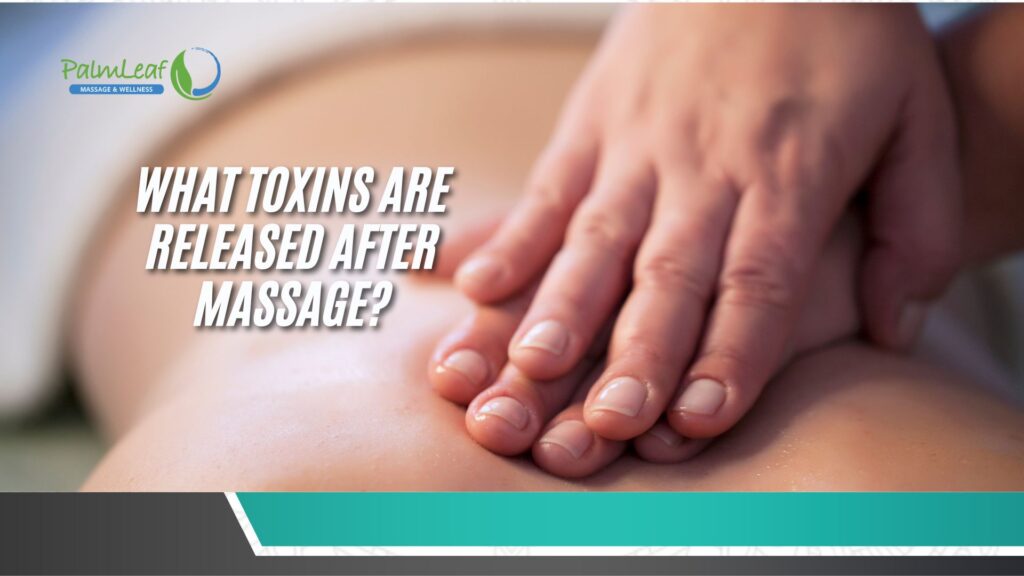Many people think getting a massage helps the body get rid of toxins, but this isn’t exactly true. While massage is great for relaxation and health, it doesn’t flush out harmful chemicals or heavy metals. What massage actually does is improve blood flow and help the lymphatic system, which moves fluids around the body. This helps clear out waste products like lactic acid and carbon dioxide, but it’s not the same as removing toxins. Some people feel sore or tired after a massage because their blood is circulating more, not because their body is detoxing.
The lymphatic system helps remove waste, but unlike the heart, it doesn’t have a pump to keep things moving. Massage helps with circulation, making it easier for the body to heal, relax, and recover.
Up next, we’ll talk about what really happens in the body after a massage and the actual benefits it provides.
Does Massage Really Release Toxins?
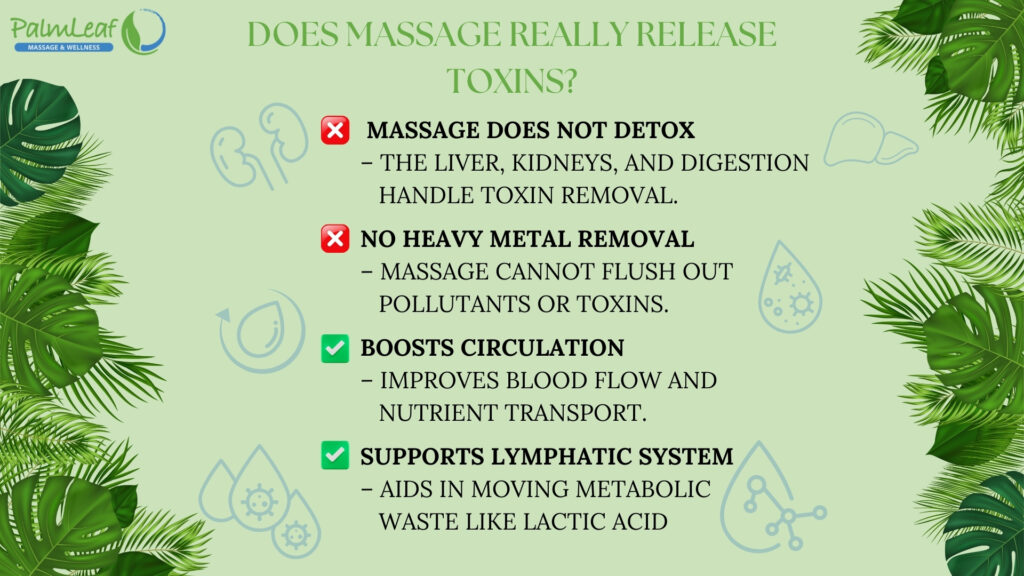
The idea that massage “releases toxins” is a widely held belief, but it’s actually a misunderstanding of how the body works. While massage has many benefits, including promoting circulation and relaxation, it does not flush out harmful toxins like heavy metals or pollutants.
The Myth about "Toxin Release"
Many people assume that massage removes toxins from the body, but in reality, true detoxification happens primarily through the liver, kidneys, and digestive system. These organs filter out harmful substances, ensuring the body stays healthy. Massage does not override or enhance these functions it simply supports the body’s natural waste management systems.
What actually occurs is an improvement in blood circulation and lymphatic flow, which helps transport essential nutrients and remove metabolic waste products like lactic acid and carbon dioxide. These byproducts are not necessarily “toxins” but are part of the body’s natural processes.
What Does the Lymphatic System Do?
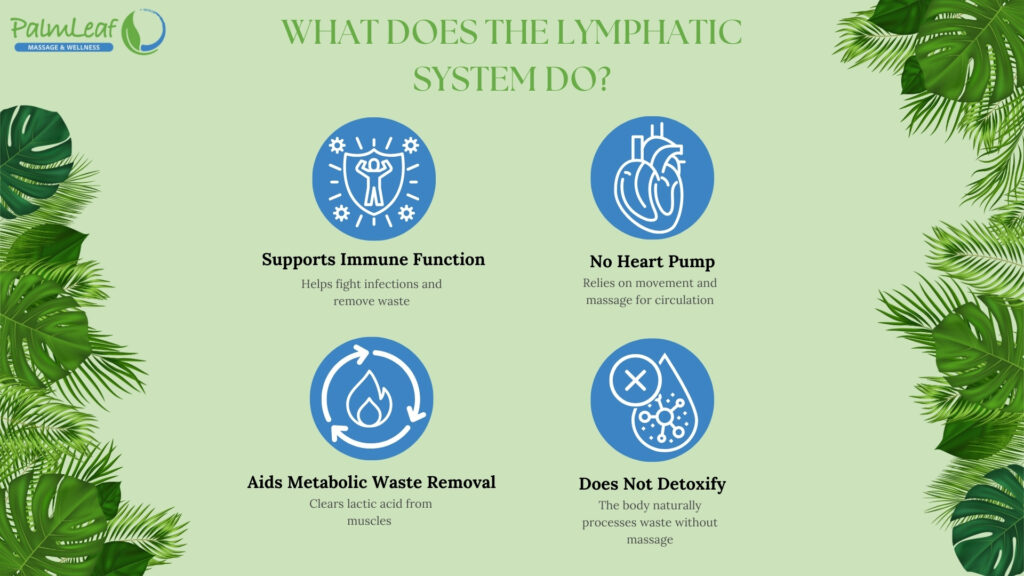
The lymphatic system plays a key role in immune function and waste removal. Unlike the cardiovascular system, which has the heart to pump blood, the lymphatic system relies on muscle movement and external stimulation (such as massage) to circulate fluid. Massage can help stimulate lymph flow, but it does not eliminate toxins in the way many believe.
Metabolic waste, such as lactic acid, accumulates in muscles during physical activity. While massage can enhance circulation and help clear these byproducts more efficiently, the body naturally processes them within hours even without massage. The idea that massage “releases toxins” oversimplifies what is actually happening.
Why Do Some People Feel Sore or Sick After a Massage?
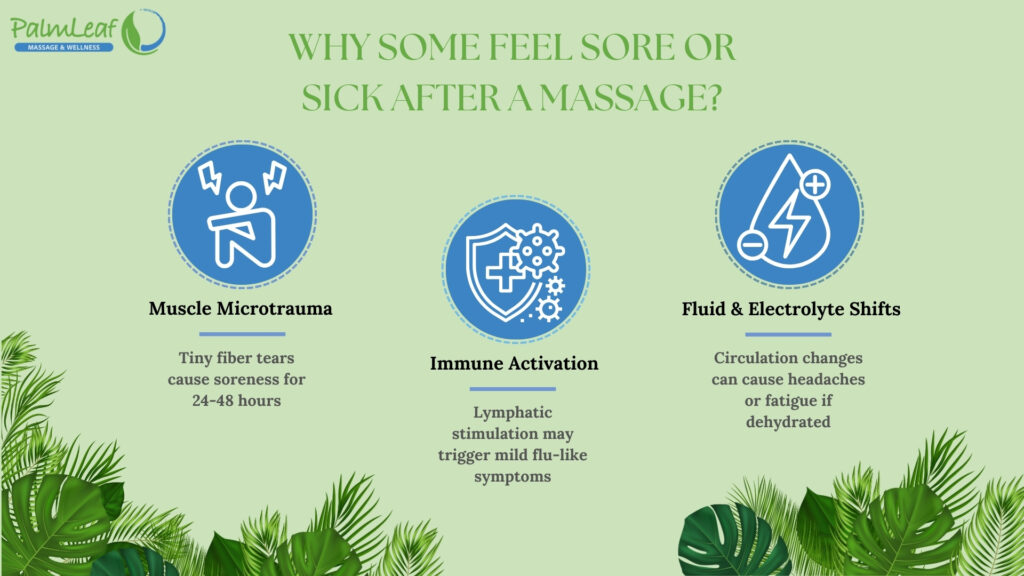
While massage offers many benefits, some people feel sore or even slightly unwell afterward. This is not due to “toxin release” but is a normal physiological response:
- Muscle Microtrauma: Deep tissue massage, like intense exercise, can cause tiny muscle fiber tears. This is part of the healing process and can lead to soreness for 24-48 hours.
- Immune Activation: Stimulating lymphatic flow might temporarily trigger an immune response, leading to mild flu-like symptoms.
- Fluid & Electrolyte Shifts: Massage increases circulation, which can lead to shifts in hydration levels. If you’re dehydrated, this can cause headaches or fatigue.
The Truth: Massage Helps, But Doesn’t Detox
Massage offers many health benefits, but it’s not a detoxification method. Instead, it helps improve circulation, reduce muscle tension, and support the body’s natural processes.
If you’re experiencing post-massage discomfort and want to learn more about why this happens, check out our in-depth guide on why some people feel flu-like symptoms after a massage?
While massage can aid circulation and recovery, it does not expel toxins from the body. Understanding these facts ensures we appreciate massage therapy for what it truly offers: relaxation, muscle relief, and overall well-being.
What Happens in the Body After a Massage?
Many people feel relaxed and refreshed after a massage, but what’s really happening inside the body? A massage doesn’t just make you feel good it triggers a series of changes in your muscles, bloodstream, nervous system, and immune response that contribute to both short-term relief and long-term health benefits.
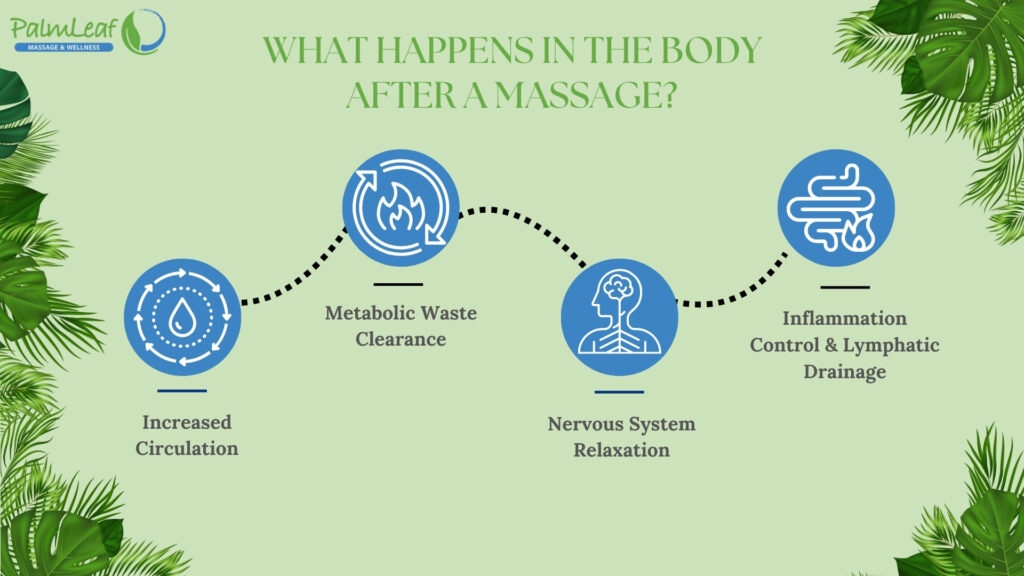
1. Increased Circulation → More Oxygen & Nutrients for Muscles
Massage applies pressure to the body, which temporarily compresses blood vessels. When the pressure is released, these vessels expand, leading to improved blood flow (vasodilation). This allows more oxygen and essential nutrients like glucose and amino acids to reach your muscles, helping them repair and function better.
- Reduced Fatigue & Cramping: When muscles don’t get enough oxygen, they become fatigued and cramp up. Better circulation helps prevent this.
- Boosted Recovery: Oxygen fuels ATP production in muscle cells, supporting energy generation and faster healing.
2. Metabolic Waste Clearance → Flushing Out Byproducts
When muscles work, they produce waste products that need to be removed. The body naturally clears these through the bloodstream and lymphatic system, and massage helps speed up this process.
- Lactic Acid: Contrary to popular belief, lactic acid isn’t a toxin. It’s a temporary byproduct of muscle activity that clears within a few hours. Massage can help move any residual lactic acid, reducing post-exercise soreness.
- Carbon Dioxide (CO₂): A byproduct of cellular respiration, CO₂ is transported by the blood to the lungs, where it’s exhaled. Massage supports this process by increasing circulation.
- Inflammatory Molecules: Cytokines and prostaglandins are substances released during inflammation. By enhancing circulation and lymphatic drainage, massage helps clear these out, reducing swelling and discomfort.
3. Nervous System Relaxation → Lower Stress & Anxiety
Massage doesn’t just work on muscles it also affects your nervous system. It activates the parasympathetic nervous system (PNS), which shifts the body from “fight-or-flight” mode into “rest-and-digest.”
- Lower Cortisol Levels: Massage can reduce cortisol (the stress hormone) by up to 30%, leading to lower stress, improved mood, and decreased anxiety.
- Endorphin Release: The body produces endorphins, serotonin, and dopamine, which help relieve pain and create a sense of well-being.
- Pain Relief: According to the Gate Control Theory of Pain, massage can interfere with pain signals, making you feel more comfortable.
4. Inflammation Control & Lymphatic Drainage
Inflammation is a natural part of muscle recovery, but excessive inflammation can lead to stiffness and pain. Massage helps regulate this process by:
- Decreasing Pro-Inflammatory Cytokines: It reduces markers like TNF-α and IL-6, which are linked to chronic inflammation.
- Increasing Anti-Inflammatory Markers: It boosts substances like IL-10, which help calm the immune system and promote healing.
- Supporting Lymphatic Drainage: Unlike blood, lymph fluid doesn’t have a pump (like the heart). Massage techniques like effleurage (light strokes) help move excess fluid and waste, reducing swelling, stiffness, and discomfort.
5. How to Support Your Body After a Massage?
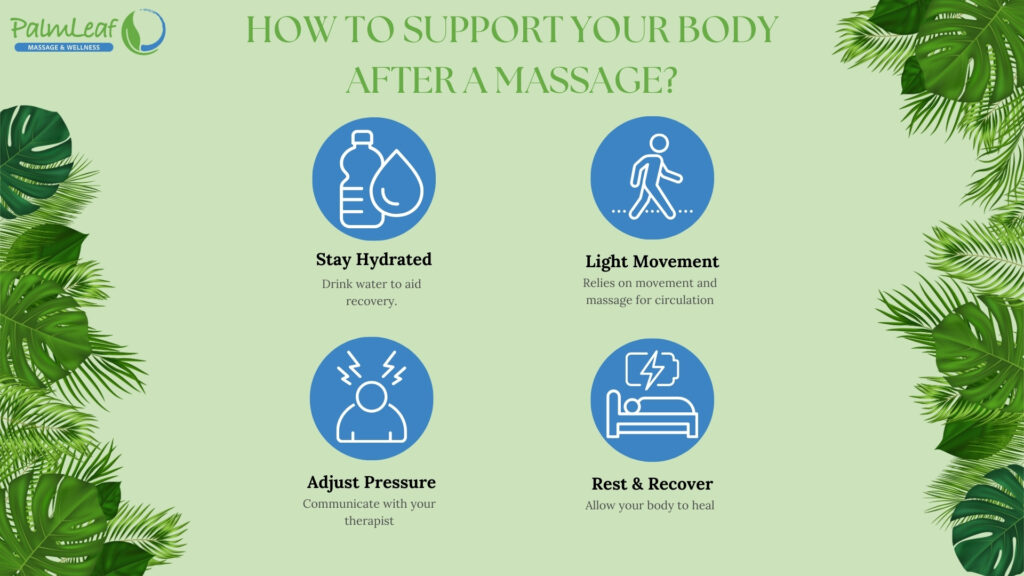
To maximize the benefits and minimize discomfort, follow these simple steps:
- Drink plenty of water to help flush out metabolic waste.
- Stretch or take a short walk to keep circulation moving.
- Communicate with your therapist about pressure preferences to avoid excessive muscle strain.
- Get rest if you feel fatigued your body is in recovery mode.
- Massage → ↑ blood or lymph flow → faster waste removal (lactic acid, CO₂, cytokines).
- ↓ Cortisol → reduced stress-driven inflammation → fewer inflammatory byproducts.
- ↓ Inflammation + ↑ O₂ or nutrients → muscle repair, reduced soreness, and improved recovery.
This synergy explains why massage can feel both immediately soothing (nervous system relaxation) and long-term restorative (reduced inflammation, better waste clearance).
What Toxins Are Commonly Believed to Be Released?
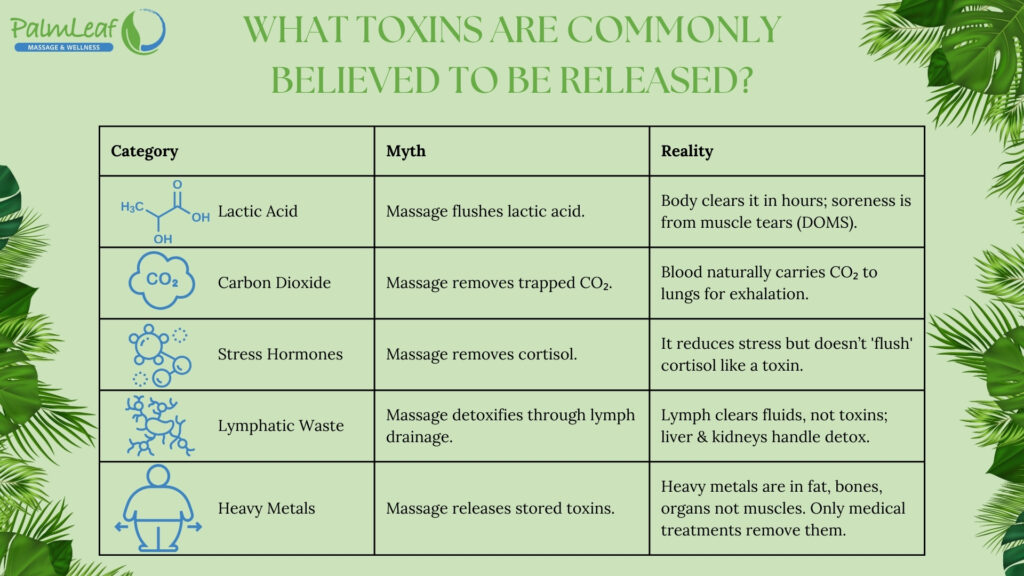
Massage is often claimed to “release toxins” from the body, but what does that really mean? Many people confuse metabolic waste (normal byproducts of bodily functions) with actual toxins (harmful substances like heavy metals or chemicals). Let’s break down some of the most commonly mentioned “toxins” and what really happens during a massage.
Lactic Acid: The Misunderstood Byproduct
- The Myth: People often believe that massage helps flush out lactic acid, preventing soreness.
- The Reality: Lactic acid isn’t a toxin. It’s a temporary byproduct of intense exercise, and your body clears it on its own within a few hours. Research shows that massage doesn’t remove lactic acid any faster than rest. Muscle soreness is usually caused by tiny tears in muscle fibers (Delayed Onset Muscle Soreness, or DOMS), not lactic acid buildup.
Carbon Dioxide & Cellular Waste: Normal Body Processes
- The Myth: Massage helps remove “trapped” carbon dioxide and waste from tissues.
- The Reality: Carbon dioxide (CO₂) is a normal waste product of breathing and metabolism. It’s carried by your blood to the lungs and exhaled. While massage improves circulation, it doesn’t “release” CO₂ your body already does this efficiently on its own.
Excess Cortisol & Stress Hormones: Balancing the Nervous System
- The Myth: Massage removes stress hormones like cortisol from the body.
- The Reality: Massage can reduce cortisol levels by promoting relaxation, but it doesn’t flush cortisol out like a toxin. Instead, it helps regulate stress by shifting your body from “fight-or-flight” mode (sympathetic nervous system) to “rest-and-digest” mode (parasympathetic nervous system). This can lead to lower anxiety, better sleep, and improved mood.
Lymphatic Waste: Supporting Natural Drainage
- The Myth: Massage releases “toxins” through the lymphatic system.
- The Reality: The lymphatic system helps clear excess fluid, immune cells, and cellular debris. While manual lymphatic drainage massage can help with swelling, it doesn’t remove toxins in the way some claim. The liver and kidneys are the body’s main detoxifiers, not the lymphatic system.
Heavy Metals & Environmental Toxins: Stored Elsewhere
- The Myth: Massage can release heavy metals and pollutants from the body.
- The Reality: Toxins like lead, mercury, and pesticides are stored in fat, bones, or organs not muscles. They’re processed by the liver and kidneys and require medical interventions like chelation therapy to be removed. Massage has no effect on these toxins.
In summary, massage therapy is a powerful tool for enhancing circulation, easing muscle tension, and promoting overall well-being but it isn’t a detox miracle. While improved blood flow and stimulated lymphatic drainage help clear out metabolic byproducts like lactic acid and carbon dioxide, these processes support the body’s natural healing rather than eliminating harmful toxins. True detoxification is managed by the liver, kidneys, and digestive system. By understanding the real benefits of massage, you can better appreciate its role in recovery and relaxation, without expecting it to purge environmental toxins or heavy metals.
Frequently Asked Questions
What chemical is released when you get a massage?
Massage triggers the release of several important chemicals that promote relaxation, well-being, and pain relief:
- Endorphins – These are natural painkillers that help reduce discomfort and create a sense of euphoria.
- Oxytocin – Often called the “bonding hormone,” oxytocin promotes feelings of connection, warmth, and relaxation.
- Serotonin & Dopamine – These “feel-good” neurotransmitters boost mood, reduce anxiety, and contribute to a sense of happiness.
- Cortisol Decrease – Massage helps lower cortisol, the primary stress hormone, which can reduce anxiety and improve overall relaxation.
This combination of chemicals helps explain why massage is not only physically relieving but also mentally and emotionally soothing.
Why is my pee dark after a massage?
Seeing darker urine after a massage can happen for a few reasons:
- Dehydration: Massage can increase circulation and stimulate fluid movement. If you haven’t had enough water, your urine may become more concentrated and appear darker.
- Metabolic Waste Removal: As circulation improves, metabolic waste is filtered through the kidneys. This can make urine appear darker and more odorous.
- Mild Muscle Breakdown: Though rare, an intense deep tissue massage can cause minor muscle breakdown, releasing myoglobin, which can darken urine.
💡 What to do? Drink water before and after your massage to stay hydrated. If dark urine persists or you feel unwell, consult a doctor.
What happens if you don't drink water after a massage?
While skipping water after a massage won’t harm most people, it can lead to some minor discomforts:
- Increased Soreness: Massage helps move metabolic waste like lactic acid. Without water, these byproducts may linger, leading to prolonged stiffness.
- Dehydration Symptoms: You might feel headaches, dizziness, or fatigue due to fluid shifts in the body.
- Slower Recovery: Hydration supports the lymphatic system, which removes waste. Not drinking enough water might slow this process, affecting recovery.
- Muscle Cramps: Dehydration can cause an electrolyte imbalance, leading to cramping.
- Reduced Circulation: Thickened blood from dehydration may impact blood flow, counteracting some benefits of the massage.
- Possible Swelling: Without adequate hydration, lymphatic drainage may be sluggish, leading to minor fluid retention.
💡 Best practice? Drink 1-2 glasses of water after a massage and continue hydrating throughout the day for optimal recovery.
What not to eat after a massage?
Post-massage, your body is in a relaxed state, and what you eat can impact how you feel. Here’s what to avoid:
1. Alcohol & Caffeine
- 🚫 Why? Both are diuretics, meaning they dehydrate the body. Hydration is essential after a massage to help flush out metabolic waste and prevent fatigue.
- ✅ Better choice: Water, herbal tea, or coconut water.
2. Processed & Salty Foods
- 🚫 Why? Excess sodium can cause water retention and bloating, which counteracts the relaxation effects of a massage.
- ✅ Better choice: Fresh fruits, vegetables, or unsalted nuts.
3. Heavy or Greasy Foods
- 🚫 Why? These foods are harder to digest and can leave you feeling sluggish instead of refreshed.
- ✅ Better choice: Light meals like salads, grilled veggies, or lean proteins.
4. Sugary Foods & Refined Carbs
- 🚫 Why? Sugar causes energy spikes followed by crashes, which can disrupt the post-massage relaxation state.
- ✅ Better choice: Whole grains or natural sugars from fruit.
5. Acidic & Spicy Foods
- 🚫 Why? If your digestive system is sensitive after a massage, acidic or spicy foods might cause discomfort.
- ✅ Better choice: Gentle, easily digestible foods like oatmeal or steamed veggies.
💡 Best practice? Eat nourishing, hydrating foods that support recovery and enhance the calming effects of the massage.


